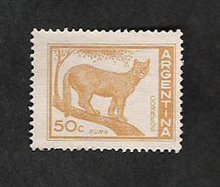
A few days ago as I was looking for interesting items in Stamp Wants, I came across an imperforated stamp, which had an oblique cut right-hand edge that made me think of a cut-out insignia, depicting Bernardino Rivadavia. I wrote to the seller telling him that I thought it was a cut-out insignia from an unused postal stationary envelope. To my surprise he responded that when he had looked at the stamp more closely again, he was able to see that it has watermark #86, which can be seen from the scan of the back, and what appears to be original gum. He asked med if I thought that a cut square from postal stationary has these features.
I took a close look to a similar Rivadavia postal stationary envelope which I have available and noticed that not only it did not have any watermark or gum, the image of Rivadavia itself, even if very similar at a first glace, was slightly different when carefully observed: it is more simplified and with less detail.
I then answered the seller that if the stamp has watermark 86 and original gum, then it is absolutely not a cut-out envelope. Postal stationary does not have these features.
What he had seemed to be half of an imperforated pair issued 1896-1897 which has, in fact, watermark 86. The seller agreed that this was the case and mentioned that the puzzling oblique cut right-hand edge is perhaps a true margin copy.
______
Details:
Scott Argentina Catalog no. 110a. Date: 1896-1897
Thanks to: Doug (Noernberg Stamps) for the stamp dialogue and the images.




